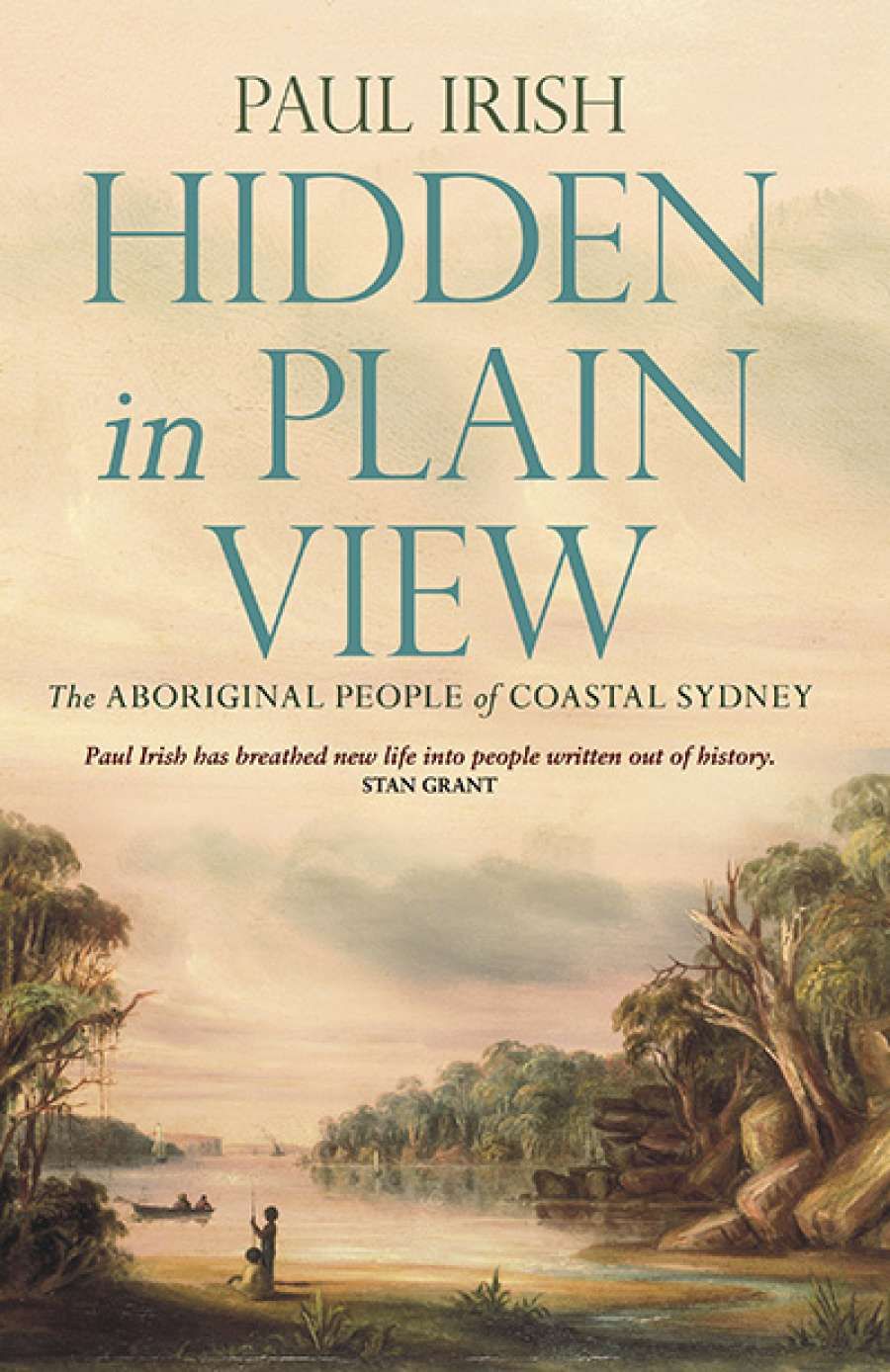
- Free Article: No
- Contents Category: Indigenous Studies
- Custom Article Title: Alan Atkinson reviews 'Hidden in Plain View: The Aboriginal people of coastal Sydney' by Paul Irish
- Custom Highlight Text:
Nothing has done more to add to the ingenuity of Australian history writing than the study of Indigenous experience. This book, which concentrates on people living in Sydney and its immediate hinterlands from 1788 to the 1930s, is a case in point ...
- Book 1 Title: Hidden in Plain View
- Book 1 Subtitle: The Aboriginal people of coastal Sydney
- Book 1 Biblio: NewSouth, $34.99 pb, 208 pp, 9781742235110
In Belich’s book, this equity is thorough but can sound slightly forced, and faintly suggestive of a political agenda. Sixteen years later, in Australia, Paul Irish does the same work more easily and delicately. He leaves more room for variations of personality and moral purpose, and yet he too is forceful enough. Like Belich, he tells a story of intelligent adaptation, insisting on the Aboriginal ‘use of old ways to respond to new realities’. The first inhabitants continued fishing, he says, but for trade as well as survival. They also made full use of ‘relationships with the first generations of Europeans to be born in Sydney’, and, just as he gives a full account of a good number of Indigenous people, he also names half a dozen influential European men who showed a particular interest in them as individuals.
Historians everywhere have been unfolding new ideas about the relationship between time and space. Horizontal networks matter more now. Irish’s archaeological experience draws him to tangible, circumscribed places, and he also joins in rethinking the nineteenth-century cartographical revolution. The nineteenth-century love of maps made jigsaws of territory the usual way of categorising human beings. Irish looks back instead to preliterate geo-politics, which preferred movement to and from a centre (like ants with their antheap) to drawing lines around and across two-dimensional spaces. In Australia, Anne Coote pioneered this insight in 2005 (her doctoral thesis), by analysing travel directions in colonial guidebooks. She showed how early guidebooks used the ancient method of getting travellers to look out for landmarks on their way (‘turn right here, turn left there’). The bird’s eye view only triumphed in the later nineteenth century, thanks to cheap and easy cartographic reproduction.
In his book, Irish includes twenty maps (three dating from the period), but the only dry-land boundary lines are those showing the area of study. Seven of the maps have been drawn to show the known movements of identifiable Aboriginal men and women, so as to give an idea of their understanding of country. In that way, the book sketches individual subjectivity, including ‘mental maps’, wherever the historic record makes that possible. It is a subjectivity that depends on settled networks of friendship and kin, and it suggests a sense of space that scholars are starting to understand much better now.
In this book, individual lives come first, from Bennelong at the very beginning to Ellen Anderson, who was born in the 1850s at Unanderra, near Lake Illawarra (her parents are named), and died in 1931 at the Aboriginal settlement at Salt Pan Creek, a tributary of George’s River. Anderson’s known movements were as far south as Kangaroo Valley and as far north as Circular Quay, where an old boatshed was for many years appropriated for Aboriginal use. As with all these individualised maps, there is a portrait of Anderson within the larger diagram, enlivening the reader’s sense of her mobile physical self.
 A view of Sydney Cove, New South Wales, engraving by Francis Jukes 1745–1812
A view of Sydney Cove, New South Wales, engraving by Francis Jukes 1745–1812
(State Library of Victoria)
Irish makes no reference to Belich or Coote, but he does acknowledge a significant debt to Grace Karskens, one of his PhD supervisors. Karskens’s great book, The Colony: A history of early Sydney (2010), takes a similar approach to networks of movement and memory, Black and White, though in her case the main story was White. Like Karskens, Irish also makes good use of evidence hidden within the oral cultures of people living today. Gathering evidence from living people is conversational in a large sense. It gives and takes at the same time, because the scholar builds up an audience by his or her own listening. Irish, and Karskens for that matter, does this, not so as to upstage traditional forms of history-writing, but in the best traditions of open-minded scholarship.
There are larger complexities. The national story, well established now, tells of the European wish to displace, confine, and, as some hoped, exterminate the Indigenous peoples. And yet this book, justifiably called Hidden in Plain View, shows some of those peoples living in numbers unremarked at the very heart of European settlement. By Irish’s account, in coastal Sydney they were exempt from the strictures of the Vagrancy Act, they travelled free by tram, their European allies gave them fishing boats and food, and for decades they kept up camps, unmolested, along the Harbour shore.
It would have been useful to have had another chapter working out this larger conundrum. The project so far is puzzling, and yet, even so far, it is wonderfully enlightening and wise, and a great delight to read.


Comments powered by CComment